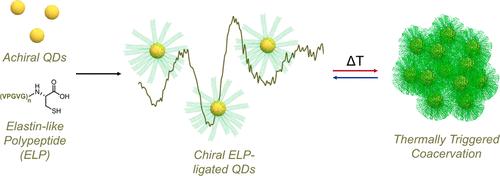热响应性弹性蛋白样多肽诱导量子点的手性
IF 3.9
2区 化学
Q2 CHEMISTRY, MULTIDISCIPLINARY
引用次数: 0
摘要
圆二色性(CD)光谱已成为探测天然非手性量子点(QDs)上手性小分子配体交换的有力工具。在这项研究中,我们报告了一种新的方法,通过使用c端半胱氨酸残基工程的热响应弹性蛋白样多肽(ELPs)诱导CdS量子点的手性来识别量子点-生物分子相互作用。我们的方法是基于一个通用的两步配体交换过程,从非极性介质中的单分散油酸盖顶量子点开始,然后通过一个容易获得的非手性甘氨酸盖顶量子点中间体。在可见范围内,与量子点电子跃迁相对应的诊断性CD响应证实了elp与量子点的成功共轭。通过动态光散射、小角度x射线散射和电子显微镜观察到,所得的ELP:CdS共轭物表现出热可逆的凝聚。该研究为利用QD电子跃迁中的诱导手性来探测QD与复杂肽和蛋白质的偶联提供了基础,为设计动态、刺激响应的杂化纳米材料开辟了途径。本文章由计算机程序翻译,如有差异,请以英文原文为准。

Induced Chirality in QDs Using Thermoresponsive Elastin-like Polypeptides
Circular dichroism (CD) spectroscopy has emerged as a potent tool for probing chiral small-molecule ligand exchange on natively achiral quantum dots (QDs). In this study, we report a novel approach to identifying QD–biomolecule interactions by inducing chirality in CdS QDs using thermoresponsive elastin-like polypeptides (ELPs) engineered with C-terminal cysteine residues. Our method is based on a versatile two-step ligand exchange process starting from monodisperse oleate-capped QDs in nonpolar media and proceeding through an easily accessed achiral glycine-capped QD intermediate. Successful conjugation of the ELPs onto the QDs is confirmed by the diagnostic CD response corresponding to the QD electronic transitions in the visible range. The resulting ELP:CdS conjugates demonstrate thermally reversible coacervation, as observed through dynamic light scattering, small-angle X-ray scattering, and electron microscopy. This research provides a foundation for using induced chirality in QD electronic transitions to probe QD conjugation to complex peptides and proteins, opening pathways for designing dynamic, stimuli-responsive hybrid nanomaterials.
求助全文
通过发布文献求助,成功后即可免费获取论文全文。
去求助
来源期刊

Langmuir
化学-材料科学:综合
CiteScore
6.50
自引率
10.30%
发文量
1464
审稿时长
2.1 months
期刊介绍:
Langmuir is an interdisciplinary journal publishing articles in the following subject categories:
Colloids: surfactants and self-assembly, dispersions, emulsions, foams
Interfaces: adsorption, reactions, films, forces
Biological Interfaces: biocolloids, biomolecular and biomimetic materials
Materials: nano- and mesostructured materials, polymers, gels, liquid crystals
Electrochemistry: interfacial charge transfer, charge transport, electrocatalysis, electrokinetic phenomena, bioelectrochemistry
Devices and Applications: sensors, fluidics, patterning, catalysis, photonic crystals
However, when high-impact, original work is submitted that does not fit within the above categories, decisions to accept or decline such papers will be based on one criteria: What Would Irving Do?
Langmuir ranks #2 in citations out of 136 journals in the category of Physical Chemistry with 113,157 total citations. The journal received an Impact Factor of 4.384*.
This journal is also indexed in the categories of Materials Science (ranked #1) and Multidisciplinary Chemistry (ranked #5).
 求助内容:
求助内容: 应助结果提醒方式:
应助结果提醒方式:


